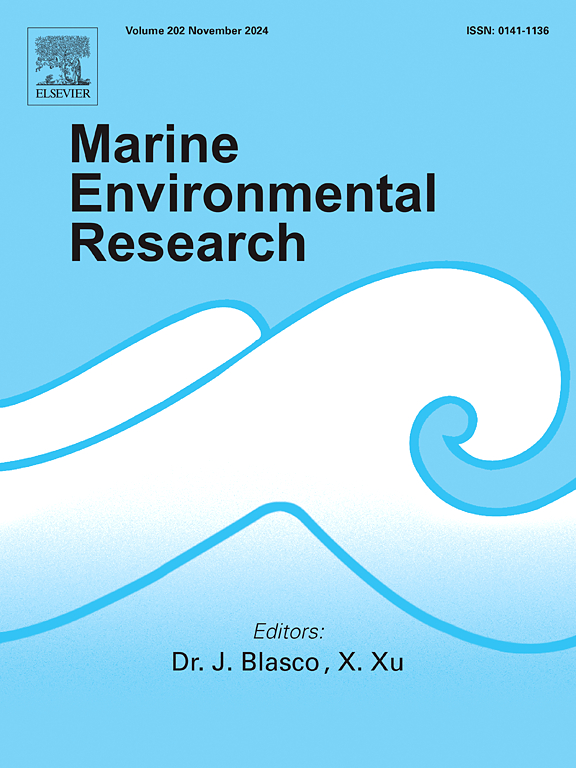IF 3
3区 环境科学与生态学
Q2 ENVIRONMENTAL SCIENCES
引用次数: 0
摘要
基础物种的长期恢复成功需要了解它们对气候变化的反应。对于分布广泛的物种来说,低纬度地区可以作为高纬度地区未来气候变暖的替代。对于分布在陡峭海拔梯度上的物种来说,这种空间-时间替代是预测气候变化的有力工具。为了了解一种重要的沿海基础物种的气候适应能力,我们考察了本地奥林匹亚牡蛎(Ostrea lurida)在从不列颠哥伦比亚到下加利福尼亚纬度 21°的 26 个地点的整个分布区的海拔上限。与我们的预期相反,高气温并没有影响奥林匹亚牡蛎上限的变化。事实上,奥林匹亚牡蛎在温度较高的南部地点一直延伸到潮间带的高处,遮阳并没有影响其上限。相反,我们的模型表明,极端低温设定了奥林匹亚牡蛎在高纬度地区的上限。相比之下,太平洋牡蛎(Magallana gigas)和藤壶都没有表现出明显的纬度模式。这些发现表明,奥林匹亚牡蛎和旨在支持其恢复的恢复项目将能够抵御气候变化模型预测的温度升高。我们的研究结果还说明了检验以下假设的重要性,即海拔梯度陡峭的物种生活在其热上限附近,将受到气候变暖的负面影响;对这一基础物种来说,这一假设是错误的。纬度研究能加深人们对物种对气候压力因素反应的理解,是设计气候适应性保护战略的关键。本文章由计算机程序翻译,如有差异,请以英文原文为准。
Setting the limit: cold rather than hot temperatures limit intertidal distribution of a coastal foundation species
Long-lasting restoration success of foundation species requires understanding their responses to climate change. For species with broad distributions, lower latitudes may serve as a proxy for future warming at higher latitudes. Such space-for-time substitutions are a powerful tool for developing climate change predictions for species distributed along steep elevational gradients. To understand climate resilience of a key coastal foundation species, we examined the upper elevational limit of the native Olympia oyster (Ostrea lurida) along its entire range at 26 sites spanning 21° latitude, from British Columbia to Baja California. Counter to our expectations, high air temperatures did not affect variation in the upper limit of Olympia oysters. Indeed, Olympia oysters extended high into the intertidal zone at the warmer southern sites, and shading did not influence the upper limit. Our models indicated instead that extreme low temperatures set the upper limit for Olympia oysters at higher latitudes. In contrast, neither the Pacific oyster (Magallana gigas), a co-occurring global invader, nor barnacles exhibited clear latitudinal patterns. These findings suggest that Olympia oysters and restoration projects aimed at supporting their recovery will be resilient to increased temperatures projected by climate change models. Our results also illustrate the importance of testing the assumption that species on steep elevational gradients are living close to their upper thermal limits and will be negatively impacted by warming; for this foundation species, the assumption was false. Latitudinal studies enhance understanding of species response to climate stressors and are key to the design of climate-resilient conservation strategies.
求助全文
通过发布文献求助,成功后即可免费获取论文全文。
去求助
来源期刊

Marine environmental research
环境科学-毒理学
CiteScore
5.90
自引率
3.00%
发文量
217
审稿时长
46 days
期刊介绍:
Marine Environmental Research publishes original research papers on chemical, physical, and biological interactions in the oceans and coastal waters. The journal serves as a forum for new information on biology, chemistry, and toxicology and syntheses that advance understanding of marine environmental processes.
Submission of multidisciplinary studies is encouraged. Studies that utilize experimental approaches to clarify the roles of anthropogenic and natural causes of changes in marine ecosystems are especially welcome, as are those studies that represent new developments of a theoretical or conceptual aspect of marine science. All papers published in this journal are reviewed by qualified peers prior to acceptance and publication. Examples of topics considered to be appropriate for the journal include, but are not limited to, the following:
– The extent, persistence, and consequences of change and the recovery from such change in natural marine systems
– The biochemical, physiological, and ecological consequences of contaminants to marine organisms and ecosystems
– The biogeochemistry of naturally occurring and anthropogenic substances
– Models that describe and predict the above processes
– Monitoring studies, to the extent that their results provide new information on functional processes
– Methodological papers describing improved quantitative techniques for the marine sciences.
 求助内容:
求助内容: 应助结果提醒方式:
应助结果提醒方式:


